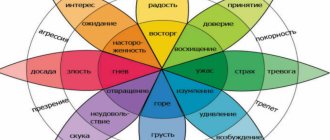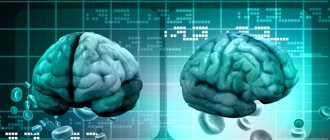As one famous movie character said: “Here I remember, here I don’t remember.” Common situation? Memory problems—temporary or permanent—occur in both children and adults. And in living conditions in modern cities, when the nervous system malfunctions and chronic fatigue syndrome becomes our constant companion, complaints about memory impairment are becoming more and more common.
Moreover, it’s impossible to concentrate... And the more problems pile up, the more demanding the boss at work, the more difficult it is to get together, remember something, force yourself to muster up the will and complete the task...
What to do in such situations, and why do they arise?
Causes of Memory Loss
- Certain injuries and pathologies of the brain - these include, for example, cancer, traumatic brain injury, stroke;
- Disruption of certain systems of the human body;
- Negative factors - sleep problems, stress, lifestyle changes, increased brain load, incl. for memory;
- Addictions – alcohol, nicotine, drugs, systematic use of sedatives;
- Age-related changes that reduce memory function.
Exercises to develop memory and attention
Exercise 1 “Remember and write”
Look carefully and remember the following picture, this picture shows animals, mammals, and fish. One minute is given to memorize. Now close the picture and write on paper from memory all the animals, mammals and fish in alphabetical order.
Write in which direction the animals are looking. If you do not remember all the animals or in the wrong order, then repeat the exercise.
Exercise 2 “Remember and write in the correct order”
Look at the following pyramid, it consists of numbers, one digit is added to each subsequent line. Remember the first three lines first, close the pyramid and write the numbers from memory.
Check yourself whether you remember everything correctly or not. Now memorize one more line and write four lines from memory. Each next time, add one line and remember. Remember and write all the numbers of the pyramid in full.
Exercise 3 “Remember and add dots from memory”
Look at the following picture, it is divided into two parts, at the top of the picture there are circles, but at the bottom of the picture there are none. Remember in which cells the circles are drawn, close the first picture and draw circles in the second part of the picture from memory. You have one minute to memorize.
Check what you got. If you have mistakes, repeat the exercise again.
Exercise 4 “Remember the words and write from memory”
In this exercise there are three columns with different words, read and remember them. You have one minute to memorize. Cover the words and write them on paper from memory in the same order.
Look what you got. If you wrote it wrong, look again carefully and repeat the exercise.
Then look at the words again and cover them. Write all the words in alphabetical order. Repeat the exercise if necessary.
Exercise 5 “Memorize and draw the shapes”
Look at the following picture for one minute. Then close this picture and try to draw these shapes in the same arrangement on paper.
If you find it difficult to remember all the details, don’t worry, take only the top part of the picture and try to remember it. Then look at the bottom of the picture and try to draw the details of the bottom picture on the paper.
After you draw the details on paper, try to compare them with the picture. What did you get? On the lower part, try to draw the upper part of the drawing from memory. If there are errors, try repeating the exercise.
Exercise 6 “Remember and write numbers and words from memory”
Look carefully at the picture, there are ten numbers drawn here, a word is written under each number. Look carefully at the picture for one minute, then close this picture and try to write all the numbers on paper and write a word under each number.
What did you get? If there are a lot of mistakes, try to remember only the top line from zero to four, then from five to nine.
Compare what is written with the picture, if there are mistakes, repeat the exercise.
Exercise 7 “Memorize and draw from memory”
Look at the next picture, there is a clock on it. Look carefully at which numbers are drawn on it more or less, what lines are on the numbers. Look at the picture for one minute, then close the picture and try to draw a clock on paper.
What did you get? If you are unable to remember and draw everything completely, divide the clock in half and remember half. Then try to remember the second half and draw it on paper. Repeat the exercise if necessary.
Exercise 8 “Remember and write in different colors”
Look at the following exercise, numbers are written here in two different colors. Look carefully at these numbers for one minute and try to remember them.
Cover these numbers and try to write on paper everything that you remember. Test yourself, if there are a lot of mistakes, try to remember the first two lines and then write them.
Then try to remember and write the second two lines. If everything is correct, you can practice and write all four lines.
Try to remember the two outer lines and write them, and then remember the two lines in the middle and write them too. Don't forget that some numbers are written in red.
Exercise 9 “Remember and continue the pattern from memory”
In this exercise, sample patterns are given, you need to remember them and continue in the same way as in the example.
First try the task number one.
Remember the drawing under the number one, close the sample and continue connecting the circles according to the pattern as a reminder.
Now look at the sample drawing under number two. Close the sample and connect the triangles for memory.
After completing task number two, proceed to task number three. Here you need to remember in what order the squares are connected. Once you have memorized, close the picture and try to connect the squares in the same way.
Exercise 10 “Memorize and draw the shapes”
Look at the next two pictures for 20 seconds, cover them and say how many identical figures are drawn in these pictures. Draw them from memory.
Now look at these two pictures again for 20 seconds and close the pictures.
How many different pictures are shown in these two pictures?
Test yourself. Repeat the exercise if necessary.
Diseases that cause memory problems
Memory impairment often appears as a result or symptom of various diseases. They are often caused by traumatic brain injuries. People who receive them note memory impairment, the degree of which directly depends on the severity of the injury. Traumatic brain injuries can lead to various types of amnesia - retrograde or anterograde. The patient may not remember either the moment of injury or the period preceding it. Sometimes memory loss is combined with the appearance of hallucinations and false memories.
The most common causes of memory problems include disruption of normal cerebral circulation. Atherosclerosis of blood vessels leads to a decrease in blood flow in all parts of the brain, and this often provokes an acute cerebral circulatory disorder. A stroke developing in one of the brain zones cuts off the blood flow to it. This leads to impaired brain activity and memory loss. Similar symptoms also occur if a person suffers from diabetes.
It's a different story with diseases that are transmitted genetically, including Alzheimer's disease. It cannot be cured, but competent therapy and care slow down the development of the disease, minimize the consequences and reduce the risk of complications.
Memory also becomes worse due to diseases of the thyroid gland, leading to iodine deficiency in the human body. This is accompanied by a tendency to obesity, apathy, depression, excessive irritability, and swelling of muscle tissue. You can avoid such manifestations if you choose the right diet, which includes frequent consumption of iodine-containing foods, as well as persimmons, seafood, seaweed, hard cheese, and nuts. The diet also includes a variety of dairy products.
But forgetfulness is not always a pathology of memory, because quite often a person consciously tries to forget difficult life situations, negative events, and tragedies from memory. In this way, the body protects its psyche and reason. If a person throws out the negative things that happened to him from his memory, then this phenomenon is called repression; he believes that certain events did not happen - denial, and if he chooses another object to displace negative emotions - replacement. Suppressed and forgotten negative emotions that have not found a way out often turn into prolonged depression and neuroses.
Brain training: restoring memory
Once you decide to take care of yourself and your nervous system, a person can take a number of simple but effective steps.
Exercising “gray cells”
You can train not only your body. A set of exercises for training memory and attention is an effective method that will restore flexibility to your mind.
Let's list just a few of the possible tasks: pronouncing words backwards (without peeking!), performing the usual manipulations with your left hand, remembering phone numbers and a shopping list... It is important to read a lot, and after you have finished the book, you should say the main ones to yourself or out loud plot elements.
A large number of exercises can be found on the Internet, in addition, the best complexes for memory training will be suggested to you by the specialists of SMC Best Clinic.
Eating right
As they say, you are what you eat. If your memory fails, you need to reinforce it with foods that are rich in microelements that are good for the brain.
So, what should you include in your diet: dairy products, fruits and vegetables (especially green leafy ones), potatoes, bananas, wholemeal flour, whole grains, seeds, nuts, dark chocolate, fish, blueberries. Don't forget about vitamins and herbs, such as pine buds and elecampane.
And - water, which is not only the source of life, but also the key to the normal flow of all processes in the body. Drink at least 1–1.5 liters of water a day and your brain will thank you.
We follow the regime
It is extremely important to get enough sleep, lead an active lifestyle, walk in the fresh air, and exercise. This will not only strengthen the body, but also improve blood supply to the brain.
Taking medications
By visiting a doctor, a person with memory problems will receive recommendations on what medications to take. Amateur activity is not allowed here. Only a neurologist or psychotherapist can prescribe the necessary medications that are suitable for your case.
It is important to follow the medication schedule and dosage.
Making IVs for the brain
An unusual method for most—drips for cerebral vessels—is nevertheless very effective. With it, drugs enter directly into the blood and are absorbed almost completely.
SMC Best Clinic specialists select a unique composition of drugs for each patient, depending on his condition and physiology. As a result, the blood vessels are restored and strengthened, and memory and attention return.
We go to a psychotherapist
Stress and nervous tension are mental conditions that are best treated by specialists such as psychotherapists. Indeed, drug treatment, proper nutrition and vitamins - all these excellent techniques sometimes give only temporary results - especially if the original cause of the problem is not eliminated.
Symptoms indicating memory impairment
Memory bells that should alert you:
- forgetfulness, manifested in everyday matters;
- difficulty focusing on a specific object;
- problems with learning and remembering information, with its reproduction;
- disruption of the thought process, loss of logical connections, loss of mental acuity;
- confusion and uncertainty;
- autism, social maladjustment;
- foggy consciousness.
Often, memory problems begin against the background of deteriorating general health. However, they can be combined:
- with headaches;
- with pressure surges;
- with hand tremors;
- with muscle spasms;
- with dizziness;
- with a decrease in visual acuity.
If, in the presence of 2-3 of the above problems, memory has decreased, you should urgently seek medical help, since these symptoms signal rapidly developing brain pathologies.
Folk remedies
Many generations have proven the effectiveness of folk remedies to combat a huge number of diseases. They also managed to figure out what to do to improve memory. There are a large number of options for drugs that can be prepared at home from plant materials.
Clover
Clover tincture eliminates forgetfulness, reduces blood pressure, and relieves headaches. It’s easy to prepare: you need to pour the plant head up to the middle of the jar, fill it with vodka, close it, and leave it for two weeks. You should drink the tincture one spoon before going to bed. Course – 3 weeks. It can be repeated after a month.
Mint with sage
The tincture helps improve brain performance and strengthen memory. The recipe does not require any special skills: mix one tablespoon of crushed herbal leaves, add water (500 ml), leave for 12 hours. You need to take 50 ml one hour before meals. Course – 2 weeks. Afterwards you will need to take a break for 1 month.
Red rowan bark
A decoction of rowan bark helps improve the quality of memory, restore it, and also increase overall brain activity. You will need one spoon of bark, which should be poured with hot water, boiled for 10 minutes, and then left to infuse for 6 hours. You need to consume 20 ml of decoction three times a day. You can take it for a month twice a year.
Other folk methods
Home remedies for improving memory are not limited to clover, sage mint and rowan bark. Other food additives you can make:
- Tincture of elecampane root;
- A decoction of bergenia, oregano, raspberry leaves;
- Calamus root powder;
- Fresh cucumber juice (can be mixed with tomato juice);
- A mixture of carrot and beet juice;
- Blueberry juice.
All of them show high effectiveness in strengthening memory and eliminating regular forgetfulness.
It is important to consider that abuse of folk remedies can cause unpleasant side effects.
How a neurologist treats memory
Before starting treatment, it is necessary to understand what disease caused the problem. Medicines should be used only those prescribed by your attending physician; self-medication is unacceptable. It is optimal to undergo a complete diagnosis of brain activity, vascular health, and electroneuromyography.
It should be remembered that rapid memory deterioration in itself is not a disease; this symptom only warns of the emergence of a more serious disease that needs to be diagnosed and therapeutic or radical treatment begun. This will help restore the previous quality of life, prevent the patient from separating from society and deteriorating adaptive functions. When memory impairment is detected, nootropic drugs are usually prescribed.
Your memory has gotten worse, you feel distracted, what should you do?
A person is by nature very smart and developed, and in order for him to remain this way throughout his life, he must develop himself every day and lead a healthy lifestyle.
You can develop your memory and attentiveness at any time, even if you have no time.
From birth to old age, develop your memory. Some people think that if they retire, then they don’t need to engage in self-development.
No, you must always practice. Children spend three months on vacation and also think that they don’t have to study. We need to study even in the summer, develop ourselves, read books.
If you train your memory and attention every day at any age, you can achieve good results.
How to improve memory. Recommendations from the Neuroscience Center
If you observe alarming symptoms in yourself or in people close to you, indicating memory problems similar to those indicated above, then you need to go to an appointment with a neurologist, neuropsychologist or therapist and undergo a series of special diagnostic tests. If you want to immediately start fighting an undesirable phenomenon before receiving the doctors’ verdict, then take action - start training your memory.
Here are some exercises to improve memory:
- If possible, perform your usual tasks with your eyes closed, from memory;
- If you are a left-handed person, do everyday tasks with your right hand, if you are right-handed, then with your left. Try this rule, for example, writing, ironing clothes, drawing, etc. – You will soon feel a positive result;
- learn Braille, which is used by blind people when reading, or learn sign language - this is useful for memory and can be useful in life;
- type texts on the keyboard with both hands, using all fingers;
- do some handicrafts - start embroidering or knitting;
- learn foreign languages and speak them more;
- try to distinguish the denomination of coins blindly, feeling them with your hands.
In addition, expand your range of interests, read more, visit places and institutions you have not been to before, go to plays and performances, walk in parks, meet and communicate with people, make new friends.
Perform the recommended exercises, follow the listed rules, take care of your health, and your memory will not fail you until old age!
The big mystery is human memory
Memory is a complex process that occurs in the central nervous system and involves the perception, accumulation, retention and reproduction of information received at different periods of time. We think most about the properties of our memory when we need to learn something new. The result of all efforts made during the learning process depends on how someone manages to catch, hold, and perceive what they see, hear or read, which is important when choosing a profession. From a biological point of view, memory can be short-term and long-term.
Information received in passing or, as they say, “it went into one ear and out of the other” is short-term memory, in which what is seen and heard is postponed for several minutes, but, as a rule, without meaning or content. So, the episode flashed and disappeared. Short-term memory does not promise anything in advance, which is probably good, because otherwise a person would have to store all the information that he does not need at all.
However, with certain efforts by a person, information that has fallen into the zone of short-term memory, if you hold your gaze on it or listen and delve into it, will go into long-term storage. This also happens against a person’s will if certain episodes are often repeated, have special emotional significance, or for various reasons occupy a separate place among other phenomena.
When assessing their memory, some people claim that their memory is short-term, because everything is remembered, assimilated, retold in a couple of days, and then just as quickly forgotten. This often happens when preparing for exams, when information is put aside only for the purpose of reproducing it to decorate the grade book. It should be noted that in such cases, turning again to this topic when it becomes interesting, a person can easily restore seemingly lost knowledge. It’s one thing to know and forget, and another thing to not receive information. But here everything is simple - the acquired knowledge, without much human effort, was transformed into sections of long-term memory.
Long-term memory analyzes everything, structures it, creates volume and purposefully stores it for future use indefinitely. Everything is stored in Memorization mechanisms are very complex, but we are so accustomed to them that we perceive them as natural and simple things. However, we note that for the successful implementation of the learning process, in addition to memory, it is important to have attention, that is, to be able to concentrate on the necessary objects.
It is common for a person to forget past events after some time if he does not periodically retrieve his knowledge in order to use it, so the inability to remember something should not always be attributed to a memory impairment. Each of us has experienced the feeling when “it’s spinning in our heads, but it doesn’t come to mind,” but this does not mean that serious disorders have occurred in our memory.
Where can you improve your memory in St. Petersburg
Where should you go if it becomes clear that memory impairment is affecting your quality of life and you urgently need to take action? Why did my memory deteriorate? A specialist neurologist at our Center for Neurology, Professor Zhulev, can answer these questions.
Make an appointment with a doctor using the phone number listed on the website. If you notice that your ability to remember dates, faces and other data has sharply deteriorated, then you need to undergo an examination and identify the reasons. Don't let your health take its course. If memory has sharply deteriorated, then this is a signal from the body about problems that have arisen, and the sooner the doctor diagnoses them, the better.
We are located in the Central district of St. Petersburg, the work schedule and map can be found in the Contacts section.
Children forget faster
As for children, all these gross, permanent memory impairments, characteristic of adults and especially the elderly, are very rarely observed in childhood. Memory problems that arise due to congenital characteristics require correction and, with a skillful approach (as far as possible), may recede a little. There are many cases where the efforts of parents and teachers literally worked wonders for Down syndrome and other types of congenital mental retardation, but here the approach is individual and dependent on various circumstances.
It’s another matter if the baby was born healthy, and the problems appeared as a result of the troubles suffered. So you can expect a child to have a slightly different reaction to different situations:
- Amnesia in children in most cases is manifested by memory lapses in relation to individual memories of episodes that took place during the period of clouding of consciousness associated with unpleasant events (poisoning, coma, trauma) - it is not for nothing that they say that children quickly forget;
- Alcoholization in adolescence also does not proceed in the same way as in adults - the absence of memories (polympsests) for events occurring during intoxication appears already in the first stages of drunkenness, without waiting for a diagnosis (alcoholism);
- Retrograde amnesia in children, as a rule, affects a short period of time before injury or illness, and its severity is not as clear as in adults, that is, memory loss in a child cannot always be noticed.
Most often, children and adolescents experience memory impairment of the dysmnesia type, which is manifested by a weakening of the ability to remember, store (retention) and reproduce (reproduction) received information. Disorders of this type are more noticeable in school-age children, as they affect school performance, adaptation in a team, and behavior in everyday life.
For children attending preschool institutions, symptoms of dysmnesia include problems with memorizing rhymes and songs; children cannot participate in children's matinees and holidays. Despite the fact that the child constantly attends kindergarten, every time he comes there, he cannot independently find his locker to change clothes; among other items (toys, clothes, a towel), he has difficulty finding his own. Dysmnestic disorders are also noticeable in the home environment: the child cannot tell what happened in the garden, forgets the names of other children, each time he perceives fairy tales read many times as if he was hearing them for the first time, does not remember the names of the main characters.
Transient disturbances of memory and attention, along with fatigue, drowsiness and all sorts of autonomic disorders, are often observed in schoolchildren with cerebrasthenic syndrome of various etiologies.
Educational games for developing memory and attention
Game 1 “Numeric Reach Revolution”
The game "Numeric Span Revolution" develops memory.
The main point of the game is to remember the numbers on the screen and dial them correctly.
In this game, numbers appear on the screen for a few seconds, you need to remember them, then they disappear, you need to type them in an empty window from memory, if you remember the numbers correctly, you move on and score points, but if you typed the numbers incorrectly three times , the game ends.
Play now
Game 2 “Fast addition reload”
The game “Fast addition reboot” develops thinking, memory and attention.
The main point of the game is to choose the correct terms, the sum of which will be equal to the given number.
In this game, three numbers are given on the screen and a task is given, add the number, the screen indicates which number needs to be added. You select two numbers from three numbers and press them. If you answered correctly, then you score points and play further.
Play now
Game 3 "Letter Span"
The game “Letter Span” develops memory and attention. The main essence of the game is to remember the letters and write them.
In this game, numbers appear on the screen for a few seconds; you need to remember them, then they disappear and you need to write them from memory; you can write letters using the keyboard. If you answered correctly, you score points and continue playing.
Play now
Game 4 "Number 3 back"
The game “Number 3 Backwards” develops memory.
The main essence of the game is to remember the sequence of numbers and compare the number on the last card with the previous card.
In this game, cards with numbers are given, you must remember the sequence of numbers that was shown on the screen and compare the number of the last card with the previous card. Read the question on the screen carefully. If you answer correctly, you score points and continue playing.
Play now
Game 5 “Memorize and call”
The game “Memorize and Call” develops memory and attention.
The main point of the game is to remember the numbers in the table and call them in ascending order.
In this game, a table with numbers is given, first the numbers are shown on the screen, you need to remember them, then the numbers are covered. Remember where the smallest number is located and click on that cell, then click on the cell where the next number goes in ascending order. Read the questions on the screen carefully.
If you answered correctly, you score points and continue playing.
Play now
Game 6 “Numerical Reach”
The game "Number Span" develops memory and attention.
The main point of the game is to remember the previous number and compare it with the current one on the screen.
In this game, numbers are shown; you need to remember them and type them in an empty window; if you remember the numbers correctly, you move on and score points, but if you type the numbers incorrectly three times, the game ends.
Play now
Game 7 "Number 2 back"
The game “Number 2 Back” develops memory and attention.
The main essence of the game is to remember the entire sequence of numbers and compare the number on the last card with the previous one on the screen.
The screen shows cards with numbers, you need to remember the numbers of the previous cards and compare them with the cards that are now on the screen. If the cards match, then answer “yes”; if the cards do not match, then answer “no”. If you answer incorrectly three times, the game ends; if you answer correctly, continue playing.
Play now
Game 8 “Memory Matrix”
The game "Memory Matrices" develops memory and attention.
The main essence of the game is to reproduce the position of the shaded figures.
In each round, a playing field consisting of cells is shown, a certain number of cells are filled in, the rest is left free. You need to remember the location of these cells and repeat their position after they have disappeared on the screen. If you check the boxes correctly, you score points and move on.
Play now
Game 9 "Spatial speed comparison"
The game “Spatial Speed Comparison” develops memory and attention.
The main essence of the game is a series of drawings on the screen; you need to compare them with the previous drawing and answer whether it is repeated or not.
In this game, a figure appears on the screen, you have to remember it, then it disappears and another figure appears. Compare the figure on the screen with the previous figure. You can answer using the “yes” and “no” buttons below. If you answer correctly, you score points and play further.
Play now
Game 10 “Find a Pair”
The game “Find a Pair” develops memory and attention.
The main point of the game is to find a picture of a twin.
In this game there is a field filled with different pictures, you need to find and mark the picture that has a twin picture. If you mark correctly, you score points and move on to play.
Play now











